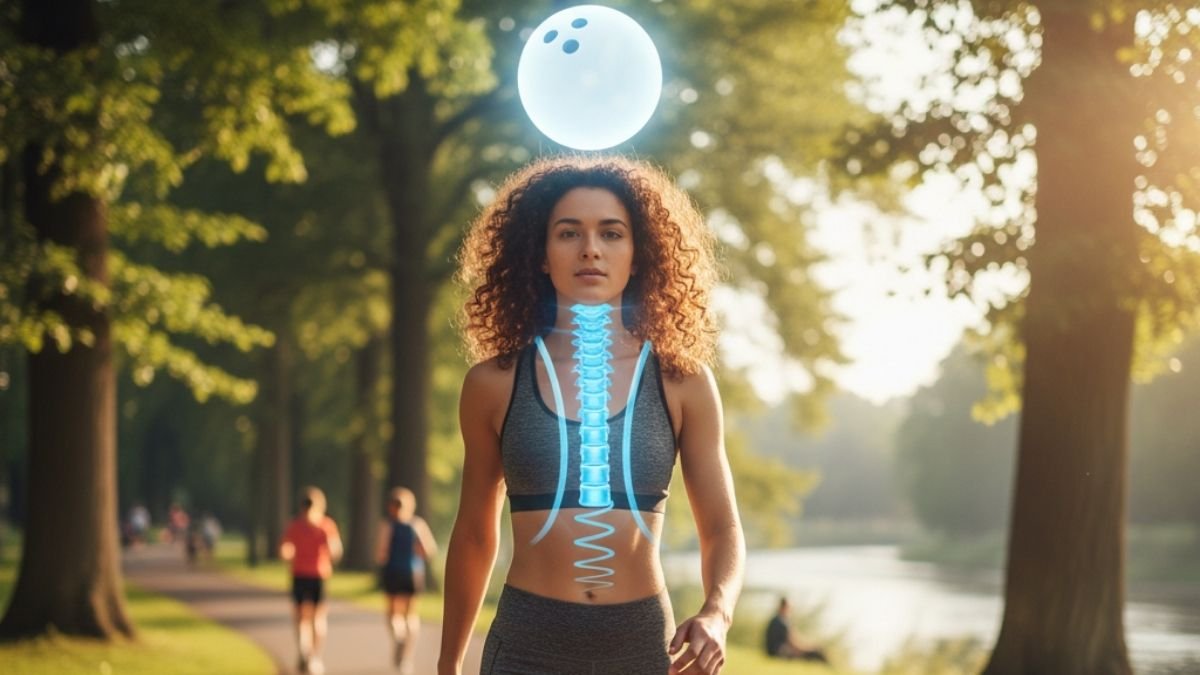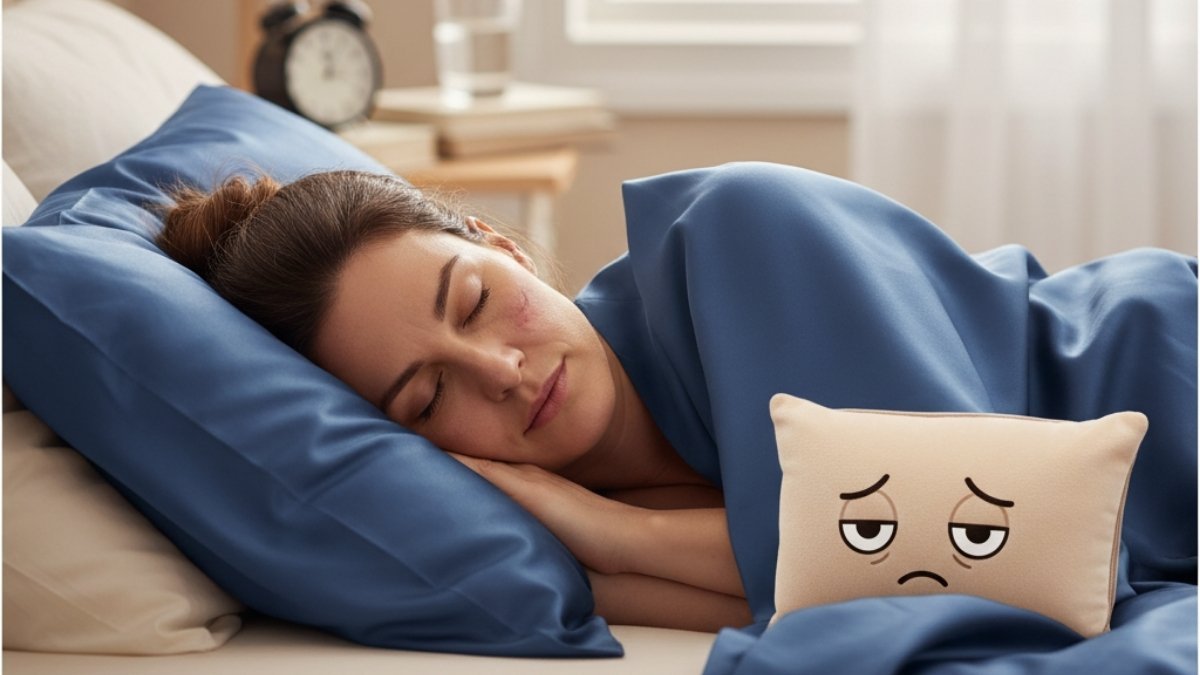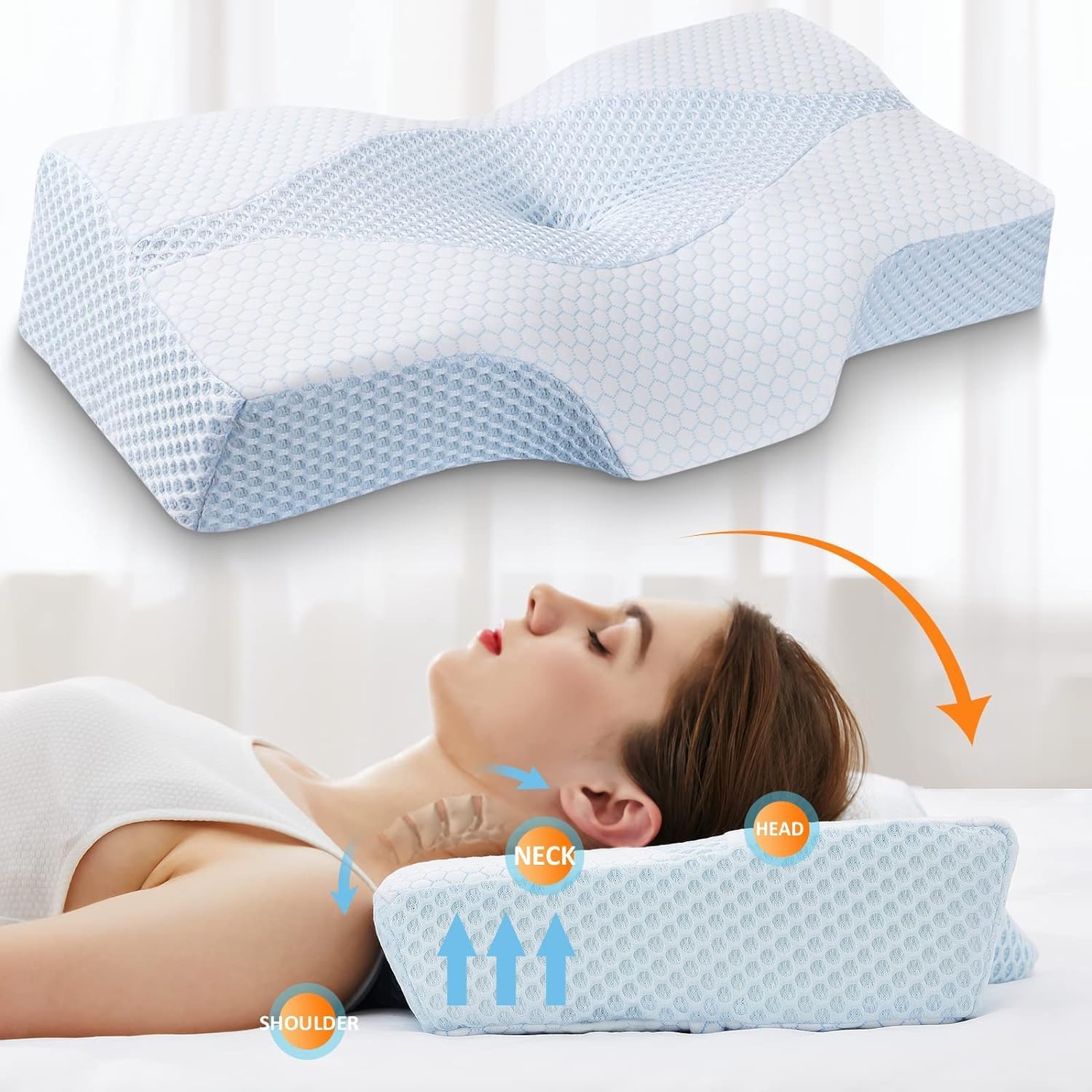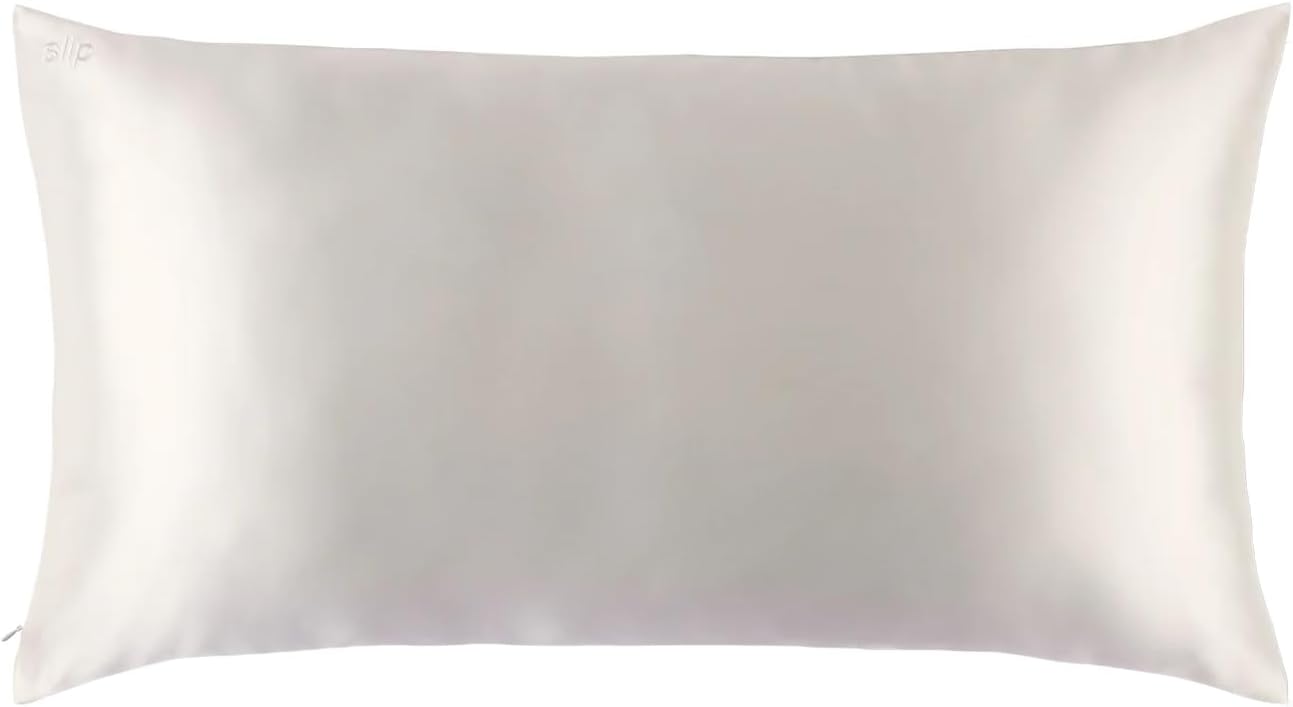
The one where you wake up, and instead of feeling refreshed, you feel… crunchy? You roll over, and your neck feels like it’s made of rusty hinges. You look in the mirror, and there are creases on your face that weren’t there when you went to bed.
We usually blame it on “sleeping funny” or just getting older. But here’s the thing: it’s probably not you. It’s your pillow.
We tend to think of pillows as just fluffy rectangles we throw on the bed for comfort. But if you talk to physical therapists, orthopedic surgeons, or dermatologists—and I’ve looked at a lot of their research from 2020 to 2025 for this—they’ll tell you something different. They view your pillow as a primary biomechanical device. It’s an orthotic. And if it’s the wrong one, it’s actively aging your spine and your skin for eight hours every single night.
Let’s dig into the science of why this is happening and, more importantly, how we can fix it without needing a PhD in physiology.
The Silent Epidemic: Why Your Neck Is Aging Faster Than You Are
The “Bowling Ball” Reality Check

Here is the biomechanical reality: Your head is heavy. In a neutral position, it weighs between 10 and 12 pounds—roughly the same as a bowling ball. When you’re walking around, your neck (the cervical spine) has a natural C-shaped curve (lordosis) that acts like a shock absorber for that weight.
But the moment you lie down, those muscles turn off. They enter a state called atonia (total relaxation). That means your muscles aren’t holding that bowling ball anymore. Your pillow is.
If your pillow doesn’t fill the exact gap between your head and the mattress, gravity takes over.
- If the pillow is too high: It forces your chin to your chest, stretching the ligaments in the back of your neck all night.
- If the pillow is too low: Your head drops back or tilts sideways, jamming the small joints (facet joints) in your spine together.
This isn’t just about waking up stiff. It’s about “micro-trauma.” It’s the subtle, repetitive strain that happens night after night. A study using finite element modeling showed that these misalignments stop your spinal discs from rehydrating. Your discs are like sponges; they need to soak up fluid while you sleep to plump back up. If your neck is kinked, that sponge stays squeezed. Over the years, this leads to dehydration of the disc, which is basically the biological definition of spinal aging.
The Connection to “Flourishing”

It’s not just about pain, either. It’s about your whole life. The National Sleep Foundation released a massive report in 2025 showing that people with high “sleep satisfaction” are nearly 90% more likely to be “flourishing” in their general lives compared to those with poor sleep. If your pillow is causing you to toss and turn (micro-arousals), you’re robbing yourself of that restoration.
The “Tech Neck” Extension: You’re Breaking It by Day, But Are You Fixing It by Night?

We have to talk about “Tech Neck.” We’re all guilty of it. We spend hours looking down at our phones or hunching over laptops. Biomechanically, for every inch your head slides forward, the weight on your neck doubles. Looking down at your phone can put 60 pounds of force on your spine.
By the end of the day, your neck muscles are exhausted and short. Sleep is supposed to be the antidote. It’s your only chance to undo that damage.
But here is where we mess up: If you have “tech neck” (forward head posture) and you sleep on a thick, puffy pillow, you are essentially locking your neck in that same stressed position all night long. You’re never letting the spine extend and recover.
Experts suggest that your pillow needs to act like a corrective brace. It should support the curve of your neck but allow the back of your head to rest further back, effectively reversing the “hunch” you developed during the day. If you don’t do this, that temporary stiffness eventually calcifies into a permanent hunch (kyphosis)—which is one of the most visible markers of old age.
The Vanity Trap: Sleep Wrinkles Are Real (And Your Pillowcase Is Guilty)

Okay, this part hurts my vanity a little, but we have to face it. Dermatologists are very clear: there are “expression wrinkles” (from smiling or frowning) and there are “sleep wrinkles”.
Sleep wrinkles are caused by shear force.
When you smash your face into a pillow, you aren’t just pressing on the skin (compression); you’re dragging it. If you move slightly, the fabric grabs your skin and pulls it, while the bone underneath stays put. This creates a shearing effect that breaks down collagen and elastin.
Unlike a smile line, these wrinkles don’t follow your muscles. They cut vertically across your cheeks or forehead in unnatural patterns. And yes, while they start as temporary morning creases, repeated nights turn them into permanent etches in your face.
The Material Matters: Silk vs. Cotton vs. Copper

- Cotton: It feels nice, but under a microscope, cotton fibers are rough. They grab your skin, creating friction. Plus, cotton is absorbent—it sucks the moisture (and your expensive night cream) right out of your face.
- Silk: This is the gold standard. Silk has a friction coefficient of just 0.1–0.2. It lets your skin glide. It doesn’t tug. It doesn’t absorb your moisture.
- Copper-Infused: This sounds like sci-fi, but the data is interesting. Studies have shown that copper oxide-impregnated pillowcases can actually reduce wrinkle depth after 4 to 8 weeks. Copper acts as a cofactor in collagen synthesis. While it’s not a miracle cure, it’s a measurable bio-hack.
The Mathematics of Comfort: Finding Your “Goldilocks” Pillow

So, how do you pick the right one? Stop guessing. You need to measure. The “perfect” pillow height (loft) depends entirely on your body and your mattress.
The Golden Rule: Neutral Alignment
You want your spine to be a straight line (if on your side) or a gentle curve (if on your back). You are trying to fill the Cervical Gap.
Pillow Prescription: Find Your Perfect Loft
Matching pillow height to your sleep position for optimal spinal alignment.
(5-7 inches)
(3-5 inches)
(< 3 inches)
The Mattress Factor

Don’t forget your bed!
- Soft Mattress: You sink in. Your shoulder sinks, so the gap between your head and the bed gets smaller. You need a thinner pillow.
- Firm Mattress: You ride on top. Your shoulder doesn’t sink. The gap is larger. You need a thicker pillow.
What’s Inside Counts: Material Guide

- Memory Foam: It’s popular for a reason. It molds to you, distributing the weight of your “bowling ball” head so you don’t get pressure points. Verdict: Great for alignment, but can get hot. Look for cooling gel or open-cell foam.
- Latex: This is rubber (natural, usually). It’s bouncy. Unlike memory foam, which has a “lag,” latex pushes back instantly. Verdict: Fantastic for durability and keeping your head lifted, not sinking.
- Feather/Down: I know, it feels like a cloud. But structurally? It’s a disaster for neck aging. It collapses under weight. By 2 AM, your head is on the mattress and your neck is bent. Verdict: Avoid for neck support unless you are willing to fluff it every time you roll over.
The “Fold Test”: Is Your Pillow Dead?

Most of us keep pillows way too long. A pillow is a consumable item, like running shoes. If the structure is gone, it’s useless. Here is the Physical Therapist’s trick to check yours right now 26:
- Take your pillow (remove the case).
- Fold it in half. squeeze out the air.
- Let go.
The Result:
- Pass: It springs back to its original shape instantly and with energy.
- Fail: It stays folded, or it slowly, sadly uncurls.
If it fails, throw it out. It’s dead. It’s forcing your muscles to do the work all night, which is why you’re waking up stiff.
Need More Help? Tools That Actually Work
Look, I’m not saying buying a new pillow will fix your entire life, but considering you spend a third of your life on it, it’s probably the most important piece of gear you own.
If you did the Fold Test and your current pillow failed, or if you’re waking up with that “tech neck” ache, here are five products that actually align with the science we just talked about. These aren’t just fluffy; they are functional.
1. Coop Home Goods Original Adjustable Pillow

This is often rated the #1 pillow for a reason. The biggest problem with pillows is that “one size fits all” is a lie. This one comes with a bag of extra fill (memory foam and microfiber blend). You unzip it and add or remove stuffing until it hits that perfect 5-inch or 3-inch height your neck needs. It’s the safest bet if you aren’t sure what height you need.
2. Mkicesky Orthopedic Contour Pillow

If you have specific neck pain or “tech neck,” a standard shape might not cut it. You need a contour. This weird-looking pillow has a specific hollow divot for your head and a ramp for your neck. It forces that cervical extension we talked about, reversing the hunch. It’s surprisingly affordable and wins blind tests against much pricier “medical” pillows.
3. Slip Pure Silk Pillowcase

If you’re worried about the “sleep wrinkles” and shear force we discussed, this is the upgrade. It uses high-grade mulberry silk (22 momme). It significantly reduces the friction coefficient compared to cotton, meaning your skin glides instead of scrunching. Plus, it doesn’t absorb your night cream.
4. Tempur-Pedic Tempur-Neck Pillow

This is the OG. You’ve probably seen it. It’s that firm, rectangular block with the wave shape. It is not fluffy. It is an orthopedic tool designed to lock your neck into alignment. If you are a back sleeper who needs serious structure to keep your airway open and neck curved, this is the gold standard.
5. Sleep & Glow Omnia Anti-Aging Pillow

This one is fascinating. It’s designed specifically for side sleepers who are worried about smashing their face. It has “cradles” on the side of the pillow, so when you roll over, your forehead and chin are supported, but your cheeks and eyes essentially float in the air. No contact = no wrinkles. It’s pricey, but it solves the biomechanical issue of face compression.
Action Plan: Your Nighttime Recovery Protocol
We can’t stop time, but we can definitely stop helping it wreck our necks. Here is your checklist to stop the aging process tonight:
- Audit Your Bed: Do the Fold Test tonight. If your pillow is a pancake, replace it.
- Measure Your Gap: Actually stand against a wall and see how much space is between your ear and the wall (for side sleepers). That is the height you need.
- Ditch the Cotton: Switch to a silk or copper-infused pillowcase. It’s the easiest anti-aging skincare product you’ll ever buy.
- Check Your Chin: When you lie down, pay attention to your chin. If it’s poking up at the ceiling, your pillow is too low. If it’s tucked into your chest, it’s too high. Find neutral.
Your sleep is supposed to be when you heal. Don’t let a $20 piece of old foam ruin 8 hours of recovery. Your neck (and your face) will thank you.






